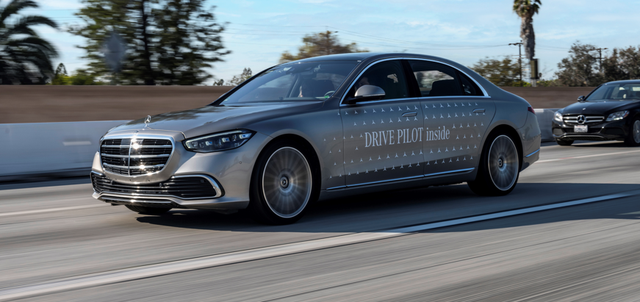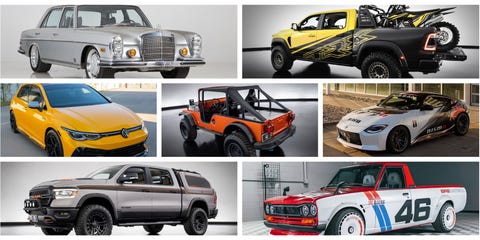- Mercedes demo'd its coming Drive Pilot Level 3 autonomous Driving system in Los Angeles last week.
- The system works only in traffic and only at speeds up to 40 mph.
- Cost might be around $5000 when it becomes available next year.
Mercedes finally showed off a real, fully functional Level 3 autonomous driving option that will be coming to its EQS and S-Class cars next year. But the system only works in heavy traffic, it's only certified for speeds up to 40 mph, and it will only be certified in states that allow for it, which right now means California and Nevada.
Still, unlike every other “self-driving” option in the world today, you do not have to keep your eyes aimed straight ahead and/or your hands on the steering wheel to let it drive for you. Those existing systems are Level 2, as defined by the SAE and other such entities.
With Mercedes’ new Level 3 Drive Pilot system, you can watch YouTube videos or sort through emails on your central screen without ever having to look up at the world around you. The car’s gigantic brain does all the driving.
Welcome to the future. Or at least a step closer to the future than we’ve ever been in a production car.
“For the first time in 136 years of automotive history, the vehicle takes over the dynamic driving task under certain conditions,” said Markus Schäfer, Member of the Board of Management of Daimler AG and Mercedes-Benz AG and chief technology officer responsible for development and purchasing.
We got a demo of the system last week in Los Angeles, a city historically beset by what some have called “soul-destroying traffic.” On a stretch of the westbound Santa Monica freeway where traffic inevitably crawls to a grinding halt, our German engineer in the driver’s seat of an S580 simply pushed a big “A” button on the steering wheel and the car started driving itself.
It was an historical moment, one which we celebrated by watching an EQC commercial starring The Weeknd singing “Blinding Lights” on YouTube. The five or ten minutes during which Drive Pilot was engaged flew by, so talented was the music performer. It was like a plane flight with a good onboard movie selection.
But then traffic picked up, the car in front of us that Drive Pilot had been tracking accelerated away, and our driver grabbed the wheel and started paying attention again. We returned to normal, old-fashioned driving.
Drive Pilot requires a car in front of it going at less than 40 mph in order to work. It follows at a prescribed distance, usually longer than what you’d program your Level 2 system to follow. The idea in the longer following distance is that it can operate more smoothly, without having to brake suddenly or accelerate to keep up. But that increased following distance could tempt other drivers to cut in front of you.
At one point when the system was engaged, a car in the lane next to us signaled and entered our lane. Drive Pilot did not anticipate this and waited until the car was about halfway into our lane before it braked a little more suddenly than was luxurious. A human driver could have anticipated it.
From our short ride in an S580, it seemed the Drive Pilot couldn’t anticipate things as well as a human. Maybe that's asking too much from here in 2022, but it was a little disappointing considering all the data the system is eating up and spitting out all the time, and that data is ginormous, requiring maybe 10 times the processing power of a Level 2 system. The trunk of our S580 was loaded up like Colossus: The Forbin Project.
Drive Pilot takes adaptive cruise control, which has been in production cars for more than 20 years, to the next level. It uses the existing sensors from Mercedes’ Driving Assistance Package, including radar, cameras, and ultrasonic sensors, and then adds Lidar, extra cameras, microphones for picking up sirens from emergency vehicles, and even a wetness sensor in the wheel well.
It also incorporates input from a digital HD map with information on road geometry, route profile, traffic signs and unusual traffic events like accidents or construction zones. But it can’t tell when some idiot next to it is on his cell phone or trying to text. Maybe a later generation will be better.
Mercedes techs say Drive Pilot could operate at higher speeds than the current 40 mph, but no government has given the ok to do so. Mercedes plans to apply for regulatory approval on certain major highways in California and Nevada by the end of this year.
If all goes well you can order your S-Class or EQS next year and it can be driving you around by next summer. That’s farther off than maybe you want to wait. But I guess that’s why they call it the future.


















